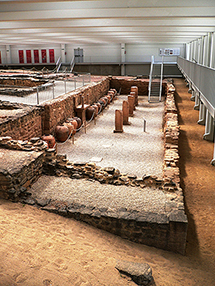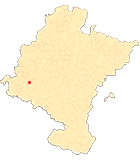The Roman villa of Arellano
Winery. Cella vinaria
The climate and geographical location of Arellano favoured the diversity of agricultural resources in Roman times. In addition to leguminous plants, vegetables and fruit trees, cereals and olives played an important role. However, the most widespread crop was the vine and wine production was one of the main activities carried out in the town. The process began with the grape harvest and the subsequent transfer of the grapes, which were loaded into baskets and transported in carts. The bunches of grapes were deposited in the torculariumThe bunches of grapes were deposited in the crushing and pressing area. The grapes were pressed in two stages, with the liquid obtained in the first stage being kept separate from that obtained in the second, which was of lower quality. The must was left to settle in the lagares(lacus vinarius), where fermentation took place, lasting seven or eight days, after which it was transferred to large ceramic vessels(dolia), where the slow fermentation was completed and finally transformed into wine. Part of the must was boiled, salted and perfumed in the cortinaleThe must was boiled, salted and perfumed in a conference room with a large hearth in the centre, and at the end of the process it was mixed with raw wine to improve it.
One of the main problems with wine in Roman times was that of its preservation. To remedy this problem, a system of artificial and accelerated ageing was applied, which consisted of subjecting it to smoke and heat for forty days in a room called a fumarium. Finally, the wine was stored in the wine cellar or cella vinaria. According to the precise instructions described by the Latin treatises, it had to be located below the level of the presses and the kitchen, and oriented to the north and west, conditions that were perfectly met in the Arellano cellar. It was located on the lower level of a two-storey rectangular building. This large space was used to store the dolia, the number of which was proportionate to the size of the vineyard.
How to get there: The easiest way to get there is from the Pamplona - Logroño motorway, a few kilometres past Estella in the direction of Logroño, take exit 51 to Arróniz, on the NA-6340. After a few kilometres, the museum complex appears on the right.
Important: All information.
scheduleSee web page.
Bibliography: María Ángeles Mezquíriz Irujo, La villa romana de Arellano, Gobierno de Navarra, Pamplona, 2003.












